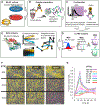Cellular Interactome Dynamics during Paclitaxel Treatment
- PMID: 31747606
- PMCID: PMC6910234
- DOI: 10.1016/j.celrep.2019.10.063
Cellular Interactome Dynamics during Paclitaxel Treatment
Abstract
Cell-cycle inhibitors, including paclitaxel, are among the most widely used and effective cancer therapies. However, several challenges limit the success of paclitaxel, including drug resistance and toxic side effects. Paclitaxel is thought to act primarily by stabilizing microtubules, locking cells in a mitotic state. However, the resulting cytotoxicity and tumor shrinkage rates observed cannot be fully explained by this mechanism alone. Here we apply quantitative chemical cross-linking with mass spectrometry analysis to paclitaxel-treated cells. Our results provide large-scale measurements of relative protein levels and, perhaps more importantly, changes to protein conformations and interactions that occur upon paclitaxel treatment. Drug concentration-dependent changes are revealed in known drug targets including tubulins, as well as many other proteins and protein complexes involved in apoptotic signaling and cellular homeostasis. As such, this study provides insight into systems-level changes to protein structures and interactions that occur with paclitaxel treatment.
Keywords: ATP synthase; chemical cross-linking; interactome; mass spectrometry; microtubules; mitochondria; mitotic inhibitor; paclitaxel; quantitative analysis; stable isotope labeling.
Copyright © 2019 The Author(s). Published by Elsevier Inc. All rights reserved.
Conflict of interest statement
DECLARATION OF INTERESTS
The authors declare no competing interests.
Figures







References
Publication types
MeSH terms
Substances
Grants and funding
LinkOut - more resources
Full Text Sources
Molecular Biology Databases
Research Materials

